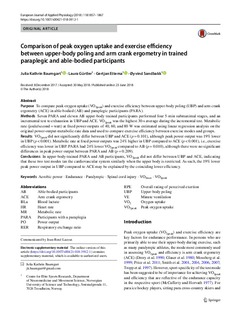| dc.contributor.author | Baumgart, Julia Kathrin | |
| dc.contributor.author | Gurtler, Laura | |
| dc.contributor.author | Ettema, Gertjan | |
| dc.contributor.author | Sandbakk, Øyvind | |
| dc.date.accessioned | 2019-01-29T12:12:35Z | |
| dc.date.available | 2019-01-29T12:12:35Z | |
| dc.date.created | 2018-12-18T14:50:53Z | |
| dc.date.issued | 2018 | |
| dc.identifier.citation | European Journal of Applied Physiology. 2018, 118 (9), 1857-1867. | nb_NO |
| dc.identifier.issn | 1439-6319 | |
| dc.identifier.uri | http://hdl.handle.net/11250/2582810 | |
| dc.description.abstract | Purpose
To compare peak oxygen uptake (VO2peak) and exercise efficiency between upper-body poling (UBP) and arm crank ergometry (ACE) in able-bodied (AB) and paraplegic participants (PARA).
Methods
Seven PARA and eleven AB upper-body trained participants performed four 5-min submaximal stages, and an incremental test to exhaustion in UBP and ACE. VO2peak was the highest 30-s average during the incremental test. Metabolic rate (joule/second = watt) at fixed power outputs of 40, 60, and 80 W was estimated using linear regression analysis on the original power-output-metabolic-rate data and used to compare exercise efficiency between exercise modes and groups.
Results
VO2peak did not significantly differ between UBP and ACE (p = 0.101), although peak power output was 19% lower in UBP (p < 0.001). Metabolic rate at fixed power outputs was 24% higher in UBP compared to ACE (p < 0.001), i.e., exercise efficiency was lower in UBP. PARA had 24% lower VO2peak compared to AB (p = 0.010), although there were no significant differences in peak power output between PARA and AB (p = 0.209).
Conclusions
In upper-body-trained PARA and AB participants, VO2peak did not differ between UBP and ACE, indicating that these two test modes tax the cardiovascular system similarly when the upper body is restricted. As such, the 19% lower peak power output in UBP compared to ACE may be explained by the coinciding lower efficiency. | |
| dc.language.iso | eng | nb_NO |
| dc.publisher | Springer | nb_NO |
| dc.rights | Navngivelse 4.0 Internasjonal | * |
| dc.rights.uri | http://creativecommons.org/licenses/by/4.0/deed.no | * |
| dc.title | Comparison of peak oxygen uptake and exercise efficiency between upper-body poling and arm crank ergometry in trained paraplegic and able-bodied participants | nb_NO |
| dc.type | Journal article | nb_NO |
| dc.type | Peer reviewed | nb_NO |
| dc.description.version | publishedVersion | nb_NO |
| dc.source.pagenumber | 1857-1867 | nb_NO |
| dc.source.volume | 118 | nb_NO |
| dc.source.journal | European Journal of Applied Physiology | nb_NO |
| dc.source.issue | 9 | nb_NO |
| dc.identifier.doi | 10.1007/s00421-018-3912-1 | |
| dc.identifier.cristin | 1645055 | |
| dc.subject.keyword | Aerobic power, Endurance, Paralympic, Spinal cord injury, VO2max, VO2peak | |
| cristin.unitcode | 194,65,30,0 | |
| cristin.unitname | Institutt for nevromedisin og bevegelsesvitenskap | |
| cristin.ispublished | true | |
| cristin.fulltext | original | |
| cristin.qualitycode | 1 | |

